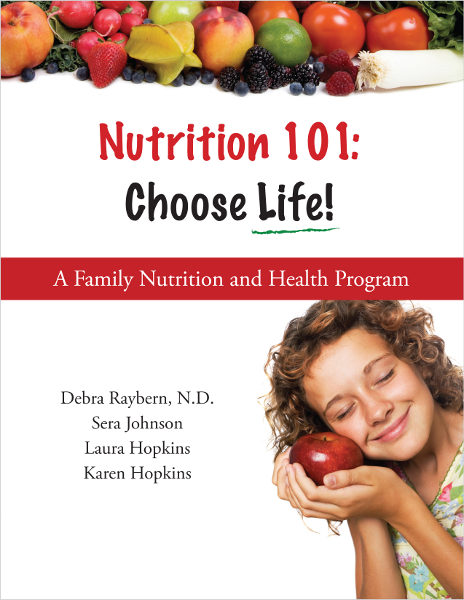Nutrition 101: Choose Life! is the type of book that should interest many homeschooling families. While it is intended to be used as a textbook, I think it might be used as a reference book more readily than as a text except in some situations which I will explain.
This 446-page book is laid out in six units, with four chapters per unit like a textbook. Each chapter concludes with discussion questions, two groups of suggested activities, and a few resource recommendations, and one or more recipes. The first group of activities covers the entire content chapter with research, investigations, writing, experiments, art projects, cooking, and other suggestions. The second group of activities relates to a recipe or foods used in a recipe. All activities are divided into two subgroups for students of different ages: elementary or secondary. The intent is that you use this text with the entire family, selecting activities to suit the ages and interests of children. The book is printed in full color with lots of photos and illustrations.
Unlike most nutrition texts, this one is written for a Christian audience with scriptural references and Bible quotations. Author Debra Raybern is a Naturopath, Herbalist, and Certified Nutritional Counselor, while another author, Karen Hopkins, is a former teacher of Home Economics and founder of Growing Healthy Homes LLC (publisher of this book). Consequently, the text stresses a natural, healthy diet and life style.
The six units of the book cover the various body systems teaching about the organs and systems, but always discussing how each relates to nutrition. For example, after presenting the various components of the respiratory system, it shifts to functional problems like coughing, allergies, asthma, respiratory syncytial virus, chronic obstructive pulmonary disease, colds, cystic fibrosis, lung cancer, pneumonia, and pulmonary hypertension. Next it explains how different food nutrients affect the respiratory system, listing “bad foods” such as dairy products, sugar, bananas, and chocolate along with refined, fried, and junk food that might cause excess mucus. It advocates and explains a cleansing routine. The chapter makes suggestions for environmental changes that might improve respiratory health, including recipes for homemade cleaning products. This chapter is typical in stating: “Food in general should be made from scratch using only whole food ingredients” (p. 106).
The book is heavily laden with recommended vitamins, minerals, and other dietary supplements, highlighting foods that contain the recommended elements. There are helpful sections that highlight potential or present health issues that are signaled by changes such as unusual thirst (might be diabetic) or cuts or cracks in fingernails that might indicate a person is not drinking enough water. There are recipes for electrolyte replacement drinks, “Super Tonic,” non-chemical sugar substitutes, and other dietary aids along with recipes using whole and natural foods. In addition, an appendix has recipes for laundry soap, spot remover, and other housekeeping products that are not toxic like those typically available. Most of the recipes offer practical ways to implement the book’s recommendations. However, some recipes call for unusual ingredients that might be challenging to obtain.
Nutrition 101 has lots of great information but it might be overwhelming to those who are not already well down the path of reorganizing their households, cooking style, dietary preferences, and budget to accommodate the huge number of changes recommended here. Some recommendations seem unrealistic to city or suburb dwellers like myself. For example, one activity following a chicken recipe says, “If your chicken does not come with labels, interview the farmer who provided the chicken to understand more about the terms free range, organic, and cage free.” I might research and discuss the terms, but I cannot imagine where I might go other than a Mexican market in the nearby barrio to purchase chicken without labels… and the barrio vendor is not likely to want to provide information on the source of his chicken. While most of the information seems credible, occasionally it makes statements that might be questionable. One example might be the discussion regarding colon cleansing and accumulation in the colon (p. 87).
Unless a family has already made significant lifestyle and dietary changes in the direction recommended by this book, a student reading this book might be frightened and overwhelmed by so much information regarding problems with their present diet, problems that they might have no power to remedy. I recommend this book only to those families who are ready and willing to make at least some of the changes. Those families ready and willing to do so should find it very valuable.
From what I can glean from the website, the book might work particularly well as a text in a co-op situation where families work together to change their dietary and lifestyle habits, teaching children (and maybe parents) in group classes. Nevertheless, if you are ready to invest the time and energy to improve your family’s nutrition, Nutrition 101 should be a great place to start to learn what to do as well as why and how to do it.
The book is also available bundled with a CD-ROM version of the book for easy printing of recipes, charts, and other pages you might find useful.










